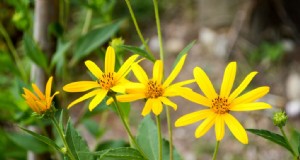Para a maior parte da história registrada, as pessoas só usavam ruibarbo medicinalmente. Nativo da China, acredita-se que Marco Polo trouxe ruibarbo de suas viagens para lá.
Rheum rhabarbarum não era usado como fonte de alimento até o final dos anos 1700. Sua primeira menção registrada é como uma planta de pizza.
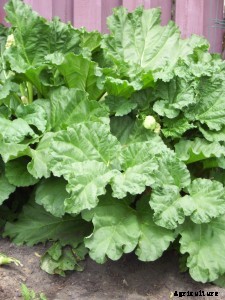
O ruibarbo foi amplamente plantado por pioneiros nos Estados Unidos, e muitas dessas plantações originais sobrevivem em nossas cidades do norte hoje.
Hardy nas zonas 3 a 8 do USDA, o ruibarbo cresce de 2 a 3 metros de altura, dependendo da variedade. Precisa de temperaturas abaixo de 40 graus para quebrar sua dormência de inverno e começar um novo crescimento na primavera.
Plante o ruibarbo a pleno sol em um rico solo de jardim. Espace as plantas com 3 a 4 pés de distância em filas de 3 pés de distância. As plantas ficarão menores e serão menos produtivas se plantadas mais próximas. Coloque a coroa cerca de 5 centímetros abaixo da superfície do solo - regue bem.
Forneça água ao ruibarbo recém-transplantado durante o primeiro ano em seu jardim. Depois disso, ele resistirá muito bem à seca.
Não colha ruibarbo no primeiro ano em que o planta. Como os aspargos, ele precisa colocar toda a sua energia na construção de um sistema de raízes forte no primeiro ano.
Colha o segundo ano com moderação. Colha apenas caules que tenham pelo menos uma polegada de espessura. Durante seu terceiro ano, colheita por cerca de um mês na primavera. Depois disso, colha os caules à medida que amadurecem para toda a temporada do ruibarbo, que dura cerca de seis semanas a partir de quando os primeiros caules estão prontos para a colheita no início da primavera.
Corte os talos na linha do solo ou segure um talo próximo à superfície do solo e torça-o para longe da copa.
O ruibarbo é a planta da torta; é usado principalmente como uma fruta em tortas, batatas fritas, compotas, e congestionamentos. Feito em um molho liso, também é um bom companheiro para frutos do mar.
Uma das minhas primeiras memórias de infância é colher um talo de ruibarbo fresco do jardim, mergulhando no açúcar, e comê-lo cru. Claro, isso foi antes de os cientistas descobrirem que o açúcar faz mal.
Eu pratico amnésia seletiva quando se trata de tais descobertas.
1. Ervilhas são vegetais antigos da primavera
Uma das minhas primeiras memórias é colher ervilhas frescas no jardim, em seguida, removê-los da vagem e comê-los crus.
Essas eram as tradicionais ervilhas de jardim inglesas que minha mãe cultivava. Eu nunca plantei ervilhas inglesas; Eu escolho usar o espaço para cultivar Ervilhas Orientais ou Ervilhas Suculentas.
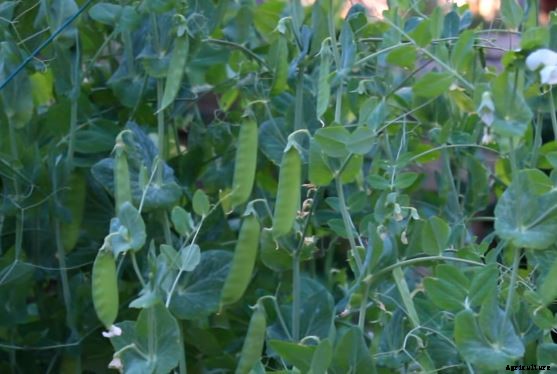
No inverno passado, ao organizar e limpar minha coleção de sementes, Encontrei dois pacotes de ervilhas - um de cada um com Snow e um Sugar Snap. Eu tinha escrito na embalagem que os colhi em meu jardim em 2002, que foi o último ano em que tive uma grande horta, devido a lesões e doenças.
Sendo um jardineiro econômico, Eu não queria jogá-los fora. Coloquei-os em um sprouter projetado para cultivar alfafa ou outros pequenos brotos para a cozinha. Como você pode ver pela foto acima, dentro de alguns dias, eles haviam brotado.
Apenas dez sementes de ervilha-da-neve brotaram, e todos, exceto um, abriram terreno no jardim. Quanto às ervilhas, apenas oito brotaram e até agora, um ou dois abriram terreno.
Pisum sativum var. macrocarpon, ou ervilhas, foi encontrado em sítios arqueológicos chineses e egípcios que datam de 12, 000 anos atrás. Pensa-se que o nome deriva da tonalidade esbranquiçada refletida nos frutos à luz do sol ou que muitas vezes crescem durante as nevadas do final da temporada.
As ervilhas não se preocupam com o tipo de solo em que crescem, desde que bem drenado; sementes de ervilha apodrecem se plantadas em solo que não drena bem.
Plante ervilhas no início da primavera, assim que você puder trabalhar o solo. Plante a cerca de cinco centímetros de distância e cerca de dois centímetros de profundidade. Quando tiver cerca de cinco centímetros de altura, fino para ficar de sete a dezoito centímetros de distância.
Fornece uma treliça para as ervilhas Snow ou Sugar Snap escalarem. Eles vão crescer muito mais altos do que suas contrapartes inglesas.
As ervilhas são uma leguminosa, e como todas as leguminosas, eles fixam nitrogênio no solo. O que isso significa para o seu jardim? As plantas pegam nitrogênio do ar (como mágica) e o exalam pelas raízes, assim, “fixando-o” no solo. Isso é mais benéfico para culturas que gostam de muito nitrogênio, como verduras ou milho.
As ervilhas param de produzir quando chega o clima quente do verão, então eles são uma colheita perfeita para o plantio de sucessão. No meu jardim este ano, Vou plantar milho bem ao lado da cerca onde as ervilhas vão escalar; eles ficarão fora do caminho uns dos outros porque o milho não terá crescido grande o suficiente para aglomerar as ervilhas antes que terminem de produzir.
Uma coisa importante a lembrar sobre ervilhas:depois que param de produzir quando chega o tempo quente, corte as vinhas ao nível do solo e deixe as raízes no solo. Eles continuarão a se decompor e adicionar nitrogênio ao solo.
Tenho certeza de que terei apenas algumas refeições da minha dúzia de vinhas de ervilha este ano, mas também vão produzir sementes para plantar no próximo ano.
Minha pesquisa revela que o novo crescimento nas pontas das vinhas de ervilha é freqüentemente cortado e frito como um vegetal em pratos orientais. Definitivamente vou tentar isso como um novo vegetal de primavera este ano.
2. Vinca Minor ilumina locais sombreados
Vinca minor é uma das plantas raras cujo nome latino é usado como nome comum. Também chamada de murta rasteira ou pervinca, vinca é uma cobertura vegetal perene perene. Ela floresce na primavera com encantadoras flores roxas que cobrem a planta.
Vinca é nativa do norte e centro da Europa e é resistente nas Zonas 3 a 9. do USDA. Em algumas áreas, pode ser considerado invasivo.
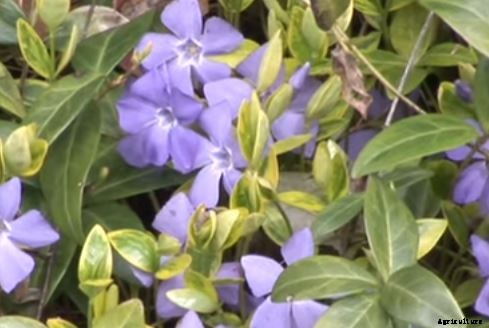
Vinca prefere crescer em sombra total a sol parcial. As folhas vão murchar, e a planta ficará sem brilho se cultivada a pleno sol.
Plantado na encosta de uma colina, vinca ajudará a prevenir a erosão. Suas raízes vão se agarrar ao solo, e eliminará quase todas as ervas daninhas. Ele vai se espalhar e lhe fornecer flores roxas na primavera e folhagem perene para o resto do ano.
Vinca vai até crescer e prosperar sob uma árvore perene.
Transplantes de vinca espaciais com cerca de 45 centímetros de distância em solo rico, em sombra parcial ou total. Regue bem no primeiro ano após o plantio, e depois disso, vinca cuidará de si mesma.
Espere que a cobertura do solo de vinca cresça e se espalhe em uma esteira de cerca de 60 a 30 centímetros de largura e 15 a 30 centímetros de altura.
O folclore nos diz que a vinca deve inspirar amor e significar as primeiras lembranças ou prazeres da memória.
Que lembranças agradáveis a vinca evoca para você?
3. Arbusto de coroa de flores de flores de primavera
Um arbusto de coroa de noiva, ou spirea, é um arbusto de floração primaveril plantado em cidades de todo o mundo.
Eles crescem bem em quase qualquer solo e, uma vez estabelecido, tolerar a seca e o abandono.
Suas delicadas flores brancas em galhos graciosos florescem de forma confiável a cada primavera.
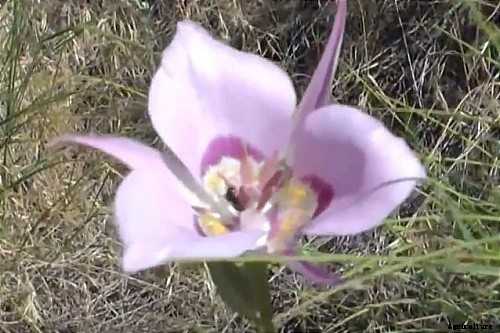
Plante a grinalda nupcial que floresce na primavera em sombra parcial. Ame-a levemente logo depois que as flores murcharem. Eles florescerão no próximo ano na madeira que cresce este ano, então poda com moderação.
O arbusto de coroa de noiva clássico é Spirea Vanhoutte. Essa variedade foi plantada extensivamente nos Estados Unidos por pelo menos cem anos. Ela cresce de 2 a 2,5 metros de altura e produz flores de um branco puro no final de maio e início de junho.
Suas flores parecem mini-buquês. Durante séculos, eles se enrolaram para fazer guirlandas ou buquês para casamentos. Seu nome latino, Spirea, vem de uma antiga palavra grega que significa torcida ou espiralada.
A coroa de flores na foto está crescendo no quintal de um prédio abandonado. Ele fica parcialmente à sombra de uma árvore de bordo, e a grama do quintal chega à altura dos joelhos. Ainda, está florescendo como se fosse cuidado por um jardineiro zeloso.
Todo jardim precisa de algumas plantas de baixa manutenção.
4. A temporada de Morel está finalmente aqui
Morels são os cogumelos selvagens indescritíveis que aparecem na primavera nas florestas do Maine, do sul para as áreas do norte do extremo sul, oeste ao norte do Texas e Oklahoma, e ao norte de Minnesota com alguns postos avançados nas Dakotas.
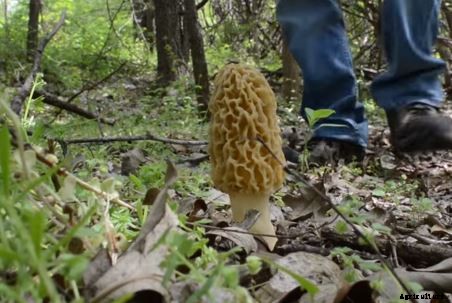
Se você nunca provou um morel, é difícil entender a sincera obsessão que os caçadores de morel têm em encontrar essas iguarias selvagens.
Última primavera, Encontrei um no meu quintal no meio da cidade. Esta Primavera, meu filho desenvolveu uma obsessão em encontrá-los. Eu raramente vi tamanha unicidade de propósito e persistência. Caçamos quase uma semana e só encontramos três pequenos.
Ontem ele pegou seu filho e saiu ao longo das margens do Mississippi perto de St. Paul e encontrou uma dúzia de padeiros. Pontuação!
Ele tirou a foto acima in situ de alguns cogumelos que encontraram.
Meu filho fez macarrão com molho de uma jarra para os dois jantarem. Ele enfiou um morel picado no molho, e seu filho disse que era delicioso. Só então a criança foi informada de que o molho continha cogumelos.
O filho do filho decidiu desde então que gosta de cogumelos.
Decidimos secar alguns cogumelos e usá-los para fazer um acompanhamento ou aperitivo para servir no Natal. Também decidimos que gostaríamos de fazer disso uma tradição anual.
E fui informado de que a caça aos cogumelos morel deste ano ainda não acabou.
Esses são meus meninos.
5. Lírio do Vale:Cobertura do Solo para Sombra
Lírio do vale é um dos muitos perfumados, flores que desabrocham na primavera. Seu nome latino, Convallaria majalis, é derivado do latim Corvallis, "vale, ”E majalis, “Floração de maio.” É a flor oficial do nascimento de maio.

Encontrei um pedaço dos menos comuns rosa (Convallaria majalis Rosea) e parei para tirar uma foto. O jardineiro me viu e insistiu em me dar um pouco para o meu jardim. Eu os plantei em uma cama que recebe sombra durante parte do dia.
Os lírios do vale preferem um local com sombra, que recebe apenas algumas horas de sol por dia. Eles gostam de solo úmido, mas não gostam de água parada. Certifique-se de que a área em que você os plantou esteja bem drenada, e nenhuma água permanece depois de uma chuva.
Cultive o lírio do vale de “sementes, ”Que são pequenos bulbilhos que se formam no subsolo junto com as raízes. Eles se espalham facilmente e vão encher uma área em apenas alguns anos.
Plante as sementes com 10 a 12 centímetros de distância na umidade, solo rico. Fertilize com um fertilizante granular na primavera e aplique cobertura morta com mofo no outono. Fora isso, seus lírios do vale vão cuidar de si mesmos.
Divida-os a cada cinco anos, para que eles não sufoquem um ao outro. Faça isso no início do outono. Desenterrar a cama inteira. Corte as raízes de modo que haja apenas um caroço por planta. Replante 4 a 5 polegadas de distância em todas as direções e regue bem. No final do outono, cubra a cama com bolor ou folhas de outono. Remova a cobertura morta no início da primavera.
Escolha os buquês depois que os primeiros "sinos" forem abertos, como o da foto. Dessa maneira, os botões próximos ao topo do caule da flor terão maior probabilidade de se abrir na casa.
Um pequeno buquê de lírios do vale vai perfumar uma sala inteira. Seu charme, As flores de tamanho pequeno são perfeitas para vasos pequenos colocados em mesinhas de cabeceira ou na penteadeira do banheiro.
Se você tiver um patch grande e paciência suficiente, você também pode secá-los para usar no potpourri. As flores secas manterão seu perfume por muitos anos.
Leia também:Corte ou Lírios com cabeça morta quando terminarem a floração.
6. Botões de solteiro - populares dentro e fora de casa
Os botões de solteiro são populares como plantas de jardim e flores de corte. Originalmente encontrado crescendo selvagem nos campos de grãos da Europa, Centaurea cyanus agora cresce selvagem em todo o hemisfério norte.
Sua cor original é azul (conforme indicado por seu segundo nome, ciano), mas agora estão disponíveis em marrom escuro, vermelho, cor de rosa, e branco. Os botões de solteiro também são comumente chamados de "centáureas" ou "vagens".
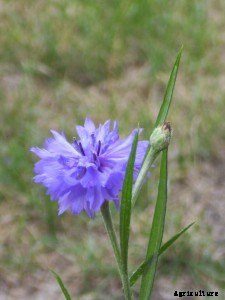
Eles crescem em todos os tipos de solo, mas preferem o sol pleno. Eles geralmente são cultivados a partir de sementes e não estão comumente disponíveis como transplantes iniciais. As centáureas semeiam-se novamente com bastante facilidade. Deixados por conta própria, eles surgirão na mesma área geral ano após ano.
Os pacotes de sementes recomendam que você as semeie cerca de duas semanas antes da geada média da última primavera. No meu jardim, as sementes lançadas no ano anterior começam a brotar pelo menos um mês antes de nossa geada média da última primavera.
Em todo o caso, plante as sementes com cerca de 1/4 de polegada de profundidade e mantenha-as úmidas até que a germinação ocorra, em cerca de 7 a 14 dias. Dilua para ficar de 20 a 30 cm de distância quando tiver cerca de 7 cm de altura.
Suas flores são comestíveis e têm gosto de cravo, com um pouco de doce e picante. Sua cor azul brilhante as torna ideais como enfeites para bolos de verão. Jogue-os em sopas e saladas frias de verão.
Feito em uma decocção, flores de centáurea são eficazes no tratamento de infecções oculares, como conjuntivite. A decocção também é usada para lavar os olhos cansados. Na medicina herbal, As centáureas são bem conhecidas por suas propriedades curativas.
As centáureas também são usadas como ingrediente no chá, incluindo a popular mistura Lady Grey. Suas flores azuis foram usadas como corante alimentar e pigmento para tintas aquarela. Várias nações e causas o adotaram como um símbolo de seu orgulho coletivo.
Numa época em que flores eram usadas como símbolos, os homens disponíveis os usariam como flor da lapela. Esta é provavelmente a origem de seu nome comum mais popular. “Botões de solteiro”.
7. Hardy hibiscus prosperam em zonas úmidas
Plantas tropicais de hibisco estão disponíveis em centros de jardinagem a cada primavera. Quando o verão acabar, esta variedade tropical, Hibiscus rosa-Sinensis, acaba no lixo ou na pilha de compostagem; eles simplesmente não são resistentes o suficiente para sobreviver ao inverno ao norte dos trópicos. E poucas pessoas têm as condições certas em suas casas para passar o inverno nas plantas dentro de casa, qualquer.
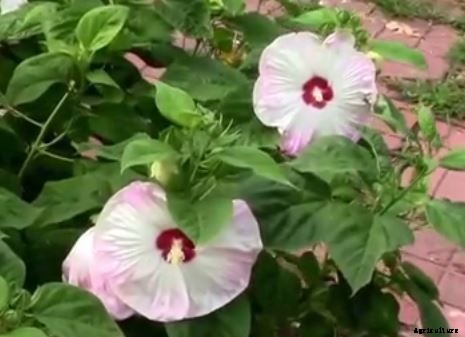
Você sabia que existe um hibisco resistente? Seu nome latino é Hibiscus moscheutos, e é comumente chamado de "malva". Eles são, claro, relacionados ao hibisco tropical, mas são nativos da América do Norte. Eles têm as maiores flores de todos os hibiscos - alguns têm 30 centímetros de diâmetro.
Hibiscus moscheutos são confiavelmente resistentes à Zona 4 do USDA, e com proteção extra de inverno, Zona 3. Embora tenham caules lenhosos, eles são considerados perenes, pois morrem completamente no inverno.
O hibisco resistente é uma das últimas plantas a começar a crescer na primavera. Freqüentemente, será final de maio ou início de junho antes que os caules comecem a crescer; não desista deles muito cedo. Eles florescerão em julho e continuarão florescendo até a geada.
Arranque as pontas em crescimento quando os galhos tiverem cerca de trinta centímetros de altura. Isso incentivará a planta a se ramificar e a produzir ainda mais flores. Não é incomum que um hibisco de malva resistente produza mais de cem flores por temporada.
Plante hibiscos resistentes a pleno sol em um solo que retenha bastante umidade. Esta é uma planta que vai crescer bem em pesadas, solo úmido. Mantenha-se bem regado ao longo da estação de crescimento, e seu hibisco resistente continuará a produzir flores mesmo na parte mais quente do verão.
Quando a planta é morta pela geada, corte os galhos alguns centímetros acima do solo e aplique cobertura morta bem antes de chegar um clima frio consistente.
O hibiscus moscheutos cresce até mesmo em pântanos ou pântanos. Eles são excelentes candidatos para áreas baixas com drenagem deficiente ou jardins pantanosos.
O hibisco robusto cresce rapidamente até uma altura de cerca de 60 centímetros. Eles são excelentes sebes de verão, crescendo rapidamente para definir uma “sala” ao ar livre ou um jardim especial.
E são perenes, então você não precisa plantá-los todos os anos.
8. Árvores de ginkgo são fósseis vivos
As árvores de ginkgo são fósseis vivos que não estão relacionados a nenhuma planta viva. Registros fósseis de espécies relacionadas terminam após a era Plioceno em todos os lugares, exceto em uma pequena área da China central.
A árvore ginkgo vive por centenas, às vezes milhares de anos. Espécimes estão crescendo perto de mosteiros na China que se acredita serem 1, 500 anos. Outros espécimes na China são conhecidos por terem mais de 3, 000 anos.
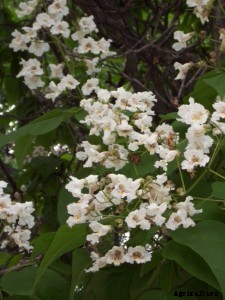
Quatro árvores ginkgo Biloba sobreviveram à bomba nuclear em Hiroshima e estão vivas naquela cidade hoje.
Eles estão entre os mais difíceis, a maioria das árvores resilientes vivas hoje e são amplamente plantadas em áreas urbanas em toda a América do Norte. Poucas pragas ou doenças os incomodam, e eles podem crescer até mais de trinta metros de altura.
Sua única desvantagem é um cheiro fétido associado às vagens de suas sementes, que pode cheirar a manteiga rançosa ou mesmo a fezes.
A árvore ginkgo é dióica, o que significa que produz plantas masculinas e femininas. Porque as fêmeas produzem vagens de sementes fedorentas, estacas de árvores masculinas são enxertadas em mudas e são plantadas com mais freqüência do que as mulheres. Eles ainda florescem, mas não produzem sementes.
A árvore ginkgo fica amarela brilhante no outono. Eles têm uma qualidade incomum, pois suas folhas ficam amarelas e caem em um curto período de 10 a 15 dias.
As árvores de ginkgo crescem em pleno sol até a sombra parcial e crescerão bem em praticamente qualquer tipo de solo, contanto que seja drenado adequadamente. Sua forma colunar e hábito de crescimento vertical os tornam naturais como árvores de sombra plantadas ao longo das ruas da cidade nas zonas 3 a 8 do USDA.
Eles florescem no final de junho aqui na Zona 4, e suas flores duram apenas alguns dias. A foto acima foi tirada no meio do verão, justo quando as flores estavam começando a murchar.
9. Black-Eyed Susans são perenes de baixa manutenção
Susans de olhos pretos são flores silvestres americanas nativas das pradarias ocidentais. Eles são uma das primeiras plantas a começar a crescer em terras que foram desmatadas.
Rudbeckia hirta é o nome latino para eles, embora sejam freqüentemente confundidos com outras variedades.
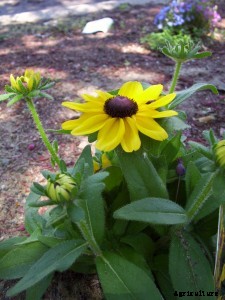
Uma coisa que as torna diferentes da maioria das outras flores silvestres é que elas não têm cheiro. Também há muito pouca história ou folclore associado aos Susans de olhos negros, muito provavelmente porque não há uso medicinal conhecido.
Susans de olhos pretos crescem melhor em pleno sol, mas não precisam de solo super fértil para crescer bem. Se o solo for muito rico, a produção de flores sofrerá.
Você pode começar Susans com olhos pretos a partir de sementes dentro de casa ou por semeadura direta no jardim. Plante sementes ao ar livre no início da primavera, assim que as temperaturas estiverem confiavelmente acima de 60 graus. Quando as mudas têm cerca de sete centímetros de altura, afinar, portanto, eles ficam a cerca de 30 centímetros de distância. Eles florescerão no primeiro ano se começarem cedo o suficiente.
Eles também estão disponíveis na primavera como plantas de canteiro. Remova todas as flores nos transplantes. Isso irá encorajar as plantas a desenvolverem sistemas de raízes fortes e recompensá-lo com mais flores no final do verão.
Coloque-os a cerca de 30 cm de distância e regue até que se estabeleçam. Uma vez que eles estão crescendo ativamente em seu jardim, Susans de olhos pretos crescem muito bem sem rega adicional.
Divida-os a cada quatro ou cinco anos, ou quando você notar que as flores estão ficando menores. Deadheading, ou removendo as flores gastas, aumentará o número de flores e a época de floração.
Black-eyed Susans são uma planta perene de baixa manutenção que resiste facilmente à seca e ao abandono.
10. Rosa abandonada continua crescendo
Rosas, que precisam de grandes quantidades de água e cuidado atencioso, estão crescendo em uma área abandonada, estacionamento cercado.
O que é incrível para mim é que acabamos de ter a terceira primavera mais seca em nossa área desde que os registros meteorológicos começaram há mais de cem anos.
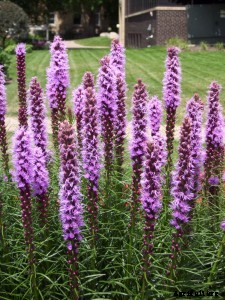
Último outono, uma lanchonete da vizinhança fechou misteriosamente no meio da jornada de trabalho. Eles colocaram o endereço do restaurante mais próximo na marquise, tapou as janelas com tábuas, e colocar uma cerca de arame ao redor de toda a propriedade.
Quase nove meses depois, Não pude deixar de notar as rosas crescendo na área de estacionamento paisagística. Tirei a foto acima através da cerca de arame erguida para manter os invasores fora.
Pelo visto, o tecido do paisagismo no canteiro de rosas mantém o mato suficiente para permitir que a rosa cresça.
Isso traz à mente as muitas sociedades de rosas que ativamente buscam e resgatam variedades de rosas antigas. Muitas rosas velhas estão crescendo selvagens sem a ajuda de jardineiros. Estas rosas são encontradas em terrenos baldios, fazendas abandonadas, e cemitérios antigos. Documento de sociedades de preservação de rosas herdadas, pegue mudas e propague rosas velhas para que não se percam para nós.
O objetivo da maioria dessas sociedades é coletar as chamadas rosas “velhas” - aquelas desenvolvidas antes de os genes das rosas chinesas serem reproduzidos no pool genético. Embora este possa ser o objetivo principal dos salvadores de rosas de família, Aposto que muitas variedades de rosas "modernas" obscuras encontraram seu caminho para a proteção e cultivo dessas organizações.
Um amante de rosas não se recusará a crescer uma bela, variedade de rosa desconhecida simplesmente porque não é velha o suficiente.
Afinal, “Uma rosa é uma rosa”.
11. Ageratum - Native American Blue-Flowering Annual
Ageratum, também chamado de “flores de algodão, ”São nativos da América Central e do México, embora quatro espécies sejam identificadas como nativas dos Estados Unidos.
A variedade mais comumente cultivada é Ageratum houstonianum. Ageratum vem do grego “a geras, "Que significa" não envelhecendo, ”Provavelmente referindo-se à longevidade das flores.
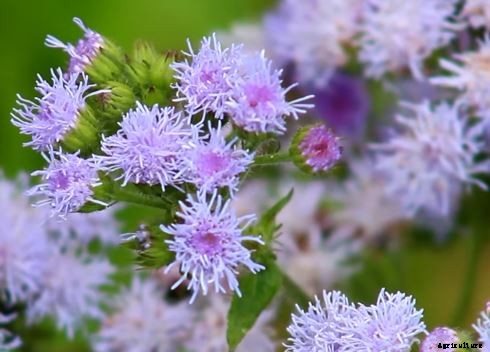
As flores são fofas e estão disponíveis em lilás, rosa ou branco, e o sempre popular azul lavanda. Eles se espalham em umbelas compostas, dando-lhes uma aparência fofa, como pompons achatados.
Como a maioria das variedades tem menos de trinta centímetros de altura, Ageratum é popular como plantas afiadas ou enfiadas em recipientes ou cestos suspensos. Eles florescem profusamente a partir de junho até serem mortos pela geada. Embora eles prefiram sol pleno, eles ficam mais felizes com um pouco de sombra durante as partes mais quentes do verão.
Você pode semeá-los diretamente no jardim, mas eles não florescerão até o meio do verão. Para flores anteriores, inicie-os dentro de casa, 6 a 8 semanas antes da última geada da primavera. As sementes precisam de luz para germinar, então polvilhe-os sobre o meio inicial de sementes e pressione levemente para baixo com a mão.
Regue a partir de baixo, colocando os potes iniciais em um recipiente maior contendo cerca de 2,5 cm de água. Remova os potes da água quando a superfície do meio inicial de sementes parecer úmida. Isso evita que as sementes sejam levadas para as profundezas do solo. Deixe o excesso de água escorrer, e não deixe os potes de partida parados em água parada. Lembre-se:as sementes precisam de luz para germinar, então eles precisam ficar na superfície do solo ou perto dela.
Flossflowers precisam de calor para germinar, então coloque os potes de partida em um local quente, como em cima da geladeira. As sementes apodrecerão se a temperatura do solo estiver abaixo de 75 °, e eles ficarão ainda mais felizes em 80 °. Se você tiver dificuldade em fornecer essas temperaturas, coloque os potes de partida em uma esteira inicial de sementes ou mesmo em uma almofada de aquecimento ajustada para a temperatura mais baixa e coberta com uma toalha dobrada.
Uma vez que as sementes estão germinadas (em cerca de 7 dias) e têm dois conjuntos de folhas, você pode cultivá-los em temperaturas tão baixas quanto 60 °. Paradoxalmente, eles precisam de temperaturas altas para germinar, mas preferem temperaturas mais frias quando em crescimento ativo. Vai saber.
Depois de endurecer, plante ao ar livre uma semana ou mais antes da geada média da última primavera. Contudo, eles são macios de geada, plantas adequadamente aclimatadas às condições externas e que cresceram no solo por mais ou menos uma semana mostram alguma tolerância a geadas leves.
Remova as flores desbotadas por deadheading para evitar a formação de sementes. Ageratum pode se tornar ervas daninhas excessivas quando cultivado fora de sua área natural.
Algumas espécies são usadas medicinalmente, embora haja poucos dados sobre usos específicos ou sua eficácia medicinal. O Ageratum houstonianum é conhecido por causar lesões no fígado ou tumores se ingerido.
Plante flores de fio dental perto de malmequeres ou quaisquer outras flores amarelas para um deslumbrante, visor de arregalar os olhos.
12. Liatris - Native American Wildflower Goes Legit
Liatris é nativo do leste dos Estados Unidos e a oeste das Grandes Planícies. Eles foram exportados para a Europa e se tornaram uma das plantas com flores mais populares cultivadas em buquês.
Uma flor silvestre indígena se torna legítima no mundo dos floristas e flores de corte.

Liatris spicata é seu nome latino; também é comumente referido como Liatris, gayfeather, e estrela em chamas.
Liatris gosta de pleno sol e vai crescer em média, solo bem drenado. Eles são muito tolerantes à seca, e suas raízes precisam crescer livres de água parada, especialmente durante o inverno. Muita água em qualquer época do ano fará com que suas raízes apodreçam. Eles toleram sombras claras, mas irão produzir menos flores.
Eles são facilmente iniciados a partir da semente ou pela divisão da raiz. Dependendo da variedade, divida as plantas a cada 3 a 4 anos e replante os rebentos divididos com 25 a 18 polegadas de distância.
As sementes precisam de um período de frio antes de germinar. Espalhe-os em seu jardim no final do outono, e muitos germinarão na primavera seguinte. Você também pode misturar suas sementes com areia úmida em um saco plástico. Refrigerar o saco por alguns meses, em seguida, plante em uma mistura inicial de sementes. Mantenha-os em torno de 70 ° -75 ° até que germinem (em cerca de 10 dias a 2 semanas). Depois disso, você pode cultivá-los em temperaturas acima dos 60º.
Plante-os ao ar livre no jardim. Afinal, o perigo de geada passou. Liatris que são iniciados a partir da semente não florescerão até o segundo ano.
Eles têm um hábito incomum de floração, ao invés das flores se abrindo de baixo para cima, assim como a maioria das flores nascidas em cachos em hastes pontiagudas, As flores Liatris abrem de cima para baixo. Você pode cortar o topo de uma das pontas, e as flores mais abaixo no caule continuarão a se abrir no jardim.
Liatris vai te dar poucos problemas, contanto que eles estejam espaçados o suficiente e o solo em que crescem seja bem drenado. Se eles ficarem muito próximos, eles são suscetíveis ao oídio. Remova as folhas afetadas ao primeiro sinal; você pode ser capaz de prevenir uma infecção generalizada.
Você notará um grande número de borboletas migrando para o Liatris. Eles são conhecidos como plantas adequadas para um jardim de borboletas. Pássaros, especialmente pintassilgos, comer suas sementes amadurecidas no final do verão e início do outono.
13. Sweet Alyssum - Dainty, Flores Brancas Perfumadas
Sweet alyssum é uma planta ideal para bordar jardins de flores ou para bordas de recipientes. Ele cresce apenas alguns centímetros de altura e, eventualmente, tomba de uma forma atraente que muitos acham charmosa.
Alyssum é uma das plantas de contêiner mais populares devido ao seu pequeno hábito de crescimento. Não se deixe enganar, pode ser pequeno, mas chama atenção.
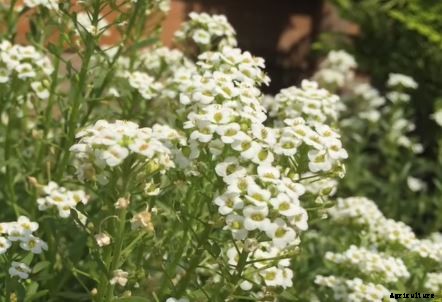
O minúsculo, flores delicadas desabrocham continuamente desde o final da primavera até que uma geada terrível termine efetivamente a estação de cultivo.
Um membro da família Cruciferous, alyssum doce é classificado botanicamente como Alyssum Maritima. Embora seu primeiro nome quase sempre se refira a ele, às vezes é chamado de "candytuft".
Alyssum doce também está disponível em rosa pastel, lavanda, e variedades roxas. Uma variedade perene produz flores amarelas de formato semelhante.
Alyssum é natural para jardineiros preguiçosos porque se auto-semeia e começa a surgir no meio da primavera, depois que o solo aquece um pouco. Se você quiser flores anteriores, você pode começar a partir da semente dentro de casa, cerca de 4 a 6 semanas antes da última geada da primavera.
Plante candytuft em pleno sol para sombra parcial. Nas áreas mais quentes do condado, eles vão apreciar sombra parcial, particularmente durante os meses mais quentes do verão. As plantas cultivadas em sombra parcial ou quase total crescerão menos vigorosamente, mas ainda assim produzirão uma quantidade respeitável de flores.
Alimente-os regularmente para que as flores continuem crescendo. É melhor usar um fertilizante líquido ou um chá feito de esterco ou composto. Isso o ajudará a evitar danos às raízes das plantas ao cultivar para incorporar fertilizantes granulares.
Alyssum começa a parecer comprida à medida que cresce e se beneficia de um bom aparamento na metade do período de cultivo. Corte as plantas pela metade. Isso os forçará a diversificar, e eles produzirão muito mais flores.
O “doce” no doce alyssum vem de sua fragrância sutil. Como outras flores sutilmente cheirosas, é melhor plantá-la perto de uma entrada ou pátio, onde seu perfume encantador pode ser apreciado por todos que passam. Como tantas outras flores brancas, parece exalar mais fragrância à noite.
Alyssum é uma boa planta para incluir em um jardim ao luar ... mas isso é outro post.
14. Coneflowers roxos - medicamento curativo para uma série de doenças
Coneflowers roxos foram amplamente utilizados pelos nativos americanos para tratar uma variedade de doenças. Seu nome botânico Echinacea purpurea vem do grego echinos (sua palavra para ouriço), que se refere ao centro espinhoso da flor, e a púrpura latina, que se refere à sua cor vermelho-púrpura.
Echinacea purpurea são plantas perenes que crescem até uma altura de 2 a 3 pés. Eles são freqüentemente propagados pela divisão da raiz, mas são facilmente iniciados a partir da semente. As plantas iniciadas a partir de sementes florescerão em outubro do primeiro ano e em julho daí em diante.
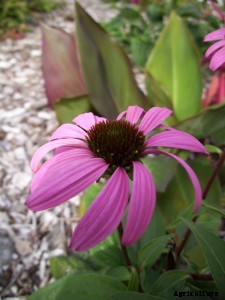
Plante equinácea em pleno sol para fazer sombra em solo argiloso fértil, embora cresçam em solo argiloso ou arenoso. Eles são relativamente resistentes à seca, mas mostrarão sinais de murchamento se o solo ficar excessivamente seco.
Divida as plantas escavando e dividindo as raízes a cada 4 a 5 anos.
Coneflowers roxos atraem uma variedade de diferentes abelhas e borboletas. Os pintassilgos comem as sementes maduras no início do outono. Suas cabeças de sementes pontiagudas adicionam um componente único aos arranjos de flores secas.
Os nativos americanos trataram de tudo, desde dores de dente a resfriados e pequenos cortes, ferimentos, e queimaduras. Em vez de usar as partes da planta para fazer um chá curativo, eles mastigaram as raízes, ou a folhagem era amassada e transformada em pomada.
Os colonizadores europeus adotaram a planta para fins medicinais até que ela caiu em desuso na década de 1930. Foi redescoberto nos últimos anos principalmente como preventivo de resfriado e gripe, embora seus usos medicinais sejam muito mais extensos do que isso.
O suco das raízes era misturado com água e aspergido sobre carvão em brasas nas tradicionais “cabanas de suor” dos nativos americanos para fins de purificação. É considerado hoje como um antibiótico e purificador do sangue que fortalece o sistema imunológico. Alguns afirmam que fornece imunidade a uma série de doenças não específicas.
A pesquisa científica ainda não determinou os compostos exatos na coneflower roxa que lhe conferem propriedades medicinais. Ainda, uma longa história de uso na medicina popular tradicional sugere que é, na verdade, eficaz como erva medicinal.
15. Petúnias - Flores para canteiros e recipientes de jardim
Petúnias estão entre as flores mais populares nos jardins domésticos urbanos, parques paisagísticos, e áreas públicas em todos os lugares. Eles também são apresentados em contêineres e cestos suspensos em cidades de todo o país.
Petúnias também são uma das mais novas flores do jardim. They are native to South America and didn’t become well-known until the last part of the 19th century. It wasn’t until the 20th century that plant breeders began to select and breed them into the modern varieties we know today.
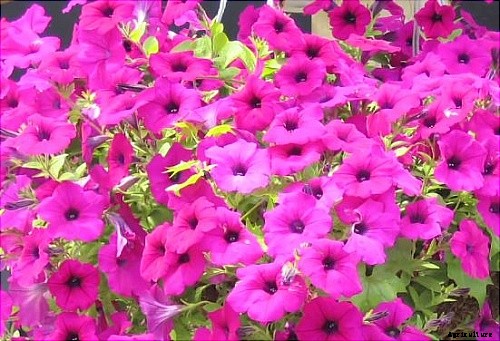
Petunias are collectively referred to today as Petunia x hybrida. They are thought to be a cross between Petunia axillaris (the night-scented white petunia) and Petunia integrifolia (a small violet-flowered variety). Petunias belong to the Solanaceae family, along with tomatoes, batatas, and tobacco.
New classes of varieties of petunias have continued to be released, with the latest big addition in the early 1990s. There are now four main classes of petunias, suited to various uses, from garden specimens to ground covers to those with pendulous habits that cascade over the edges of window boxes or hanging baskets.
These classes of petunias include groundcover or “spreading” petunias, Grandiflora petunias, multiflora petunias, and multiflora petunias. Here’s a short description of each:
Grandiflora petunias. These produce large flowers that are at least three inches across and sometimes larger. They come in single- or ruffled double-flowered varieties. Most are upright plants that develop into large, foot-high mounds of flowers.
Groundcover or “spreading” petunias. This variety grows to only about 6 inches high but spread rapidly to cover an extensive area in a single growing season. They will quickly cover several square feet and are ideal for use in hillside gardens where quick coverage is important. These spreading varieties are stunningly planted in hanging baskets or window boxes because they cascade 2 to 3 feet over the edge of the container.
Milliflora petunias. These are compact, miniature plants producing large quantities of small perfect flowers that are only 1 to 1 1/2 inches in diameter. They are perfect for the front of the flower border or in containers, especially those near the entrances of buildings, where you can enjoy the flowers up close.
Multiflora petunias. This variety has the same growth habit as grandifloras, but they are more compact plants with small but more numerous flowers. Their flowers can be single or double, but the majority of varieties are single. They make an eye-catching display massed together in a single color in the garden.
Petunias need at least six hours of sun a day to produce the abundant blooms for which they’re famous. They will grow in partial shade but will produce fewer flowers. In the Deep South and the Southwest, petunias will be happier in partial shade.
16. Hollyhocks – Old Fashioned Favorite
Hollyhocks are one of those charming old-fashioned flowers grown by our grandmothers. They deserve a place in modern flower gardens, if only for their unusual upright habit that stands out among bushier perennials.
Native to Asia, it is thought that they are one of the oldest flowers in cultivation, grown by the ancient Chinese. Hollyhocks have been found in Stone Age burial sites.
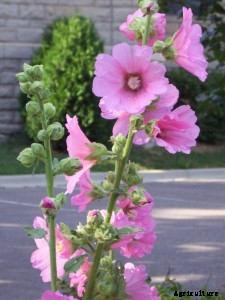
They derive their name from the Old English holi (holy) and hokke (mallow). Another early name for the plant is “St. Cuthbert’s cole.”
The leaves were formerly used as potherbs or in salads, best collected in the cool of early winter.
Most hollyhocks are classified as biennials, but a few perennial varieties and even a couple of annual varieties. The perennials are short-lived, no entanto, often only living 2 to 3 seasons. They self-seed readily and will reappear in the garden even years after removing the mother plants.
Sow seeds of hollyhocks in mid to late summer. The plants will return in spring and bloom the following summer. They like full sun and moist, rico, solo bem drenado. Barely cover the seeds and keep them moist until they germinate. Cover the small plants before consistent freezing weather sets in.
Hollyhocks are susceptible to rust, and indeed it is the most often heard complaint about them. Removing the two lowest leaves shortly after they appear sometimes helps keep the rust from attacking them. You may be able to contain the rust to the lower leaves even if it does appear. Another option is to plant shorter flowers near them to hide the rust-infected lower leaves.
Water from below and provide plants with a lot of space in which to grow and breathe. Treat plants with fungicide if you cannot tolerate looking at the rust. These measures will sometimes keep rust from attacking. If it does appear, remove the affected leaves and put them in the trash. Do not add to the compost pile.
Hollyhocks are sometimes found growing on abandoned farms or along roadsides. They also make good additions to cottage-style gardens. They grow to heights ranging from one foot up to nine feet. The taller ones work great in the back of the flower garden, and the shorter varieties can be tucked in wherever the look of their spikes is desired.
17. Sunflowers – Stately Giants of the Garden
Sunflowers are native to the Americas and have been cultivated for over 4, 000 anos. They were a major food source for the indigenous population and were even used medicinally.
Botanically called Helianthus from the Greek helios, meaning sun, and Anthus, meaning flower, sunflowers were adopted as a major crop by the Russians. Sunflower oil stays liquid at lower temperatures than animal fats, which was advantageous in their cold climate.
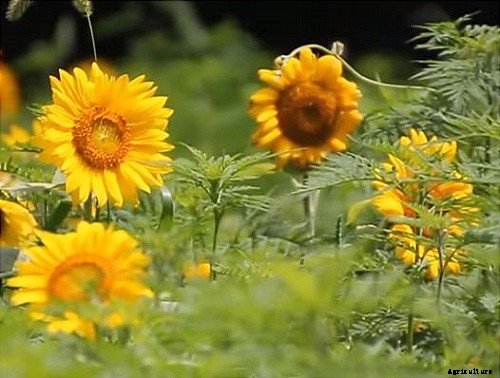
Victorians fell madly for sunflowers and used their likeness in art and architecture. Early American pioneers pounded the stalks to extract the fibers. The stalks were also used as kindling, and the seedless hulls were compressed into fire logs.
Plant sunflowers in mid-spring about 1 to 2 weeks before the date of your average last frost. They need full sun and aren’t overly fussy about soil fertility, although they benefit from a side dressing of compost.
Thin the seedlings, so the plants stand 12 to 18 inches apart, depending on the size of the variety at maturity. Many varieties will first produce a large basal flower and then branch out to produce many smaller blooms after the basal flower is cut. Some varieties naturally branch out, producing many smaller flowers.
Hybridizers have been busy, and sunflowers now come in various sizes and many colors in the yellow/gold/orange/rust family. They are spectacularly planted in various heights and colors as a theme garden.
Sunflowers reseed themselves prolifically and will come up every year, even if you don’t want them to. It goes without saying that small wildlife, such as birds and squirrels find them irresistible.
If you want to harvest the seeds for snacks or for planting next year, cover the flowers with a paper lunch bag when the seeds begin to ripen. De outra forma, the local livestock will completely devour your sunflower crop.
The blooms of sunflowers turn to follow the sun’s path, beginning in the east in the morning and continuing throughout the day. They are one of the few flowers that follow this peculiar practice.
By all means, cut them and use them in bouquets. Seu brilho, cheery colors look good in any decor.
18. Sweet Peppers Shine in Summertime Garden
Fresh summertime sweet peppers are plentiful at supermarkets and farmer’s markets everywhere. Their bright colors beckon you to look, cheiro, and buy them.
Sweet peppers are known scientifically as Capsicum annum and are members of the nightshade family. They are usually plump and bell-shaped, featuring either 3 or 4 lobes, although other sweet peppers are more tapered and have no lobes.
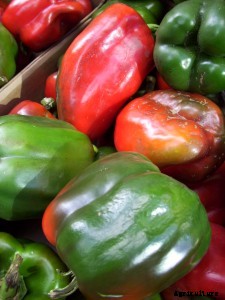
The four different types of sweet peppers are bell, banana, cubanelle, and pimento. Like their hot relatives, they also originated in the Americas. The word “chile” is from an Aztec word, “nahuatl, ” although aboriginal South Americans called it “aji.” Archeological evidence shows that Peruvians have been eating wild peppers since about 7000 BC and have cultivated them since approximately 6100 BC.
Start sweet peppers from seed indoors about 6 to 8 weeks before the average date of your last spring frost—Harden off before transplanting to the garden, which should be done when you transplant your tomatoes. Sweet peppers will not grow well in cold, wet soil and do not grow when nighttime temperatures dip below 50°.
Space pepper plants 18 to 24 inches apart in rows 24 to 36 inches apart. For intensive spacing, plant 14 to 18 inches apart in all directions. Side dress with granulated fertilizer when planting and add a scoop of compost to the planting hole. Peppers thrive in well-drained fertile soil and need consistent moisture. Apply liquid fertilizer after the first round of infant peppers have set and continue to fertilize weekly throughout the growing season.
All peppers need consistent moisture to set fruit. Lack of this or drought can cause blossoms or even infant fruits to drop off the plant. Hot, dry winds and soil can prevent the fruit from forming in the first place.
If you are a smoker, wash your hands before handling pepper plants. It is possible to transmit the tobacco mosaic disease (if present in your cigarette tobacco) to your garden sweet peppers, as they are both members of the nightshade family.
Stuffed peppers are one of the most popular ways to serve summer’s bounty of fresh sweet peppers. Most cultures have their own recipes, but all usually feature a filling of rice and some type of meat or protein, along with their favorite herbs and spices. Many other recipes use peppers in many creative ways. Their use as an integral component in recipes has become almost as commonplace as onions and garlic.
Within 50 years of being brought back to Spain, sweet (and hot) peppers spread throughout Europe and the Mediterranean region. Soon after that, Portuguese explorers had successfully introduced peppers to Africa, Índia, Sudeste da Ásia, China, e Japão.
Sweet peppers are one of the most widely used vegetables/seasonings in the world.
19. Rainbow Swiss Chard – Fresh Greens for Summer
Swiss chard is a green that grows well during the hot summer months, usually without turning bitter. Any bitterness will only be in the mature outer leaves and disappears when they are cooked. When sweltering summer weather passes, the large outer leaves will lose their bitterness, and they’ll begin to grow sweet and succulent again.
Thought to originate in Sicily, the original varieties of Swiss chard had white stems. Ainda, new varieties have been developed in recent years with stems of bright colors, such as the rainbow Swiss chard in the photo at right. Even the leaves can have a slight purple tinge.

Swiss chard was originally called “Swiss” because seed catalogs in the 19th century wanted to distinguish it from French spinach. Botanically it is called Beta vulgaris flavescens and is a member of the same family as beets. Essentially it’s a beet without a root.
Plant Swiss chard, rainbow or otherwise, in mid to late spring. Plant seeds 1/4 inch deep and an inch apart in rows 12 to 18 inches apart. When the young plants are about three inches high, thin to stand about 4 to 6 inches apart, plant them 6 to 8 inches apart in all directions for intensive spacing. It’s not overly fussy about the fertility of the soil.
If you’re a lazy gardener (like me), Swiss chard will be a good friend to your garden. It withstands neglect and will even grow during droughts.
You can start harvesting leaves of any size. You can add tender young leaves to salads or stir-fries. You should cut larger, more mature leaves from the outside of the plant, and the new leaves at the center of the plant should be left to mature.
Swiss chard will even grow in partial shade and still produce a respectable crop. It survives temperatures down into the ’20s. Even if the leaves outside the plant freeze, the inner leaves will still be intact and edible.
The entire plant is edible, but the stems need a longer cooking time than the leaves. Interessantemente, American cooks primarily use the leaves, and European cooks primarily use the stems. I use the entire plant.
The stems have the texture of cooked celery and should, na verdade, be cooked similarly. The leaves can be substituted in virtually any recipe calling for spinach, with a slightly longer cooking time.
20. Plant Peas for Fall Harvests
Late summer is the time to start planting for fall harvests. Now is the time to plant vegetables that prefer to mature during cool weather.
Plant Pisum sativum—the English garden type along with edible-podded snow and snap varieties—in early to mid-August for harvesting in mid to late September.
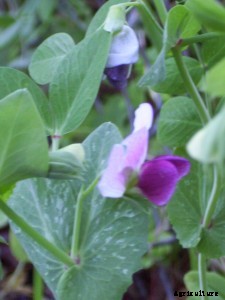
Plant peas in between the rows of corn in your garden. The corn will mature and be harvested long before the peas need the room. Another good place to plant fall peas is where lettuce or other greens were growing. These leafy crops deplete supplies of available nitrogen in the soil, and the roots of peas “fix” nitrogen into the soil.
This is a complicated scientific process that I’m not qualified to explain. Suffice it to say that it works. Once the plants are finished producing, leave their roots in the ground, and they will release the captured nitrogen into the soil, where it can be used by other plants that you subsequently grow in the same area.
When planting peas for fall, plant them almost twice as deep as spring-planted peas. This will help keep the seeds cool and also from drying out before they germinate. Em todo o caso, keep them well-watered to avoid overstressing them and also mulch the soil to keep it cool.
Space the seeds about two inches apart and thin the seedlings to about four inches apart when they’re three inches high.
Snap peas and Oriental snow peas grow tall enough to require some support for them to climb upon. English garden peas only grow about 12 to 18 inches high and do not need such support.
The blossoms and new growth shoots of pea vines are also edible. Na verdade, the seedlings that you thin are completely edible. Simply pinch off the roots and toss them into a salad or stir-fry.
Check your pea vines daily once they start producing. Edible podded peas are best eaten when the peas inside are just starting to swell. English garden peas, traditionally eaten when plump and succulent, can quickly become tough and woody if left too long on the vines.
When freezing weather kills off the vines, leave the roots in the soil. By spring, they will be nearly completely decomposed and ready to plant a crop that likes rich, well-fertilized soil, como tomates, pepinos, or melons.
21. Dusty Miller Adds Fuzzy Texture to Flower Garden
Dusty Miller has grown annually in much of the temperate zones, but it’s technically a perennial. In Zone 7 and warmer, it will survive winters and is often planted with pansies in winter flower gardens.
You can find Dusty Miller available in several cultivars under the Latin name Senecio cineraria. The first name, Senecio, comes from the Latin “senex, ” which means old man. The second name, cineraria, means ashy gray in Latin.
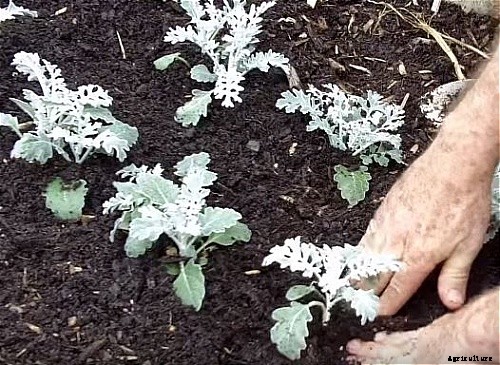
A more finely leafed variety is excellent to use in hanging baskets or any container. The lacy foliage really stands out when viewed up close.
Plant them in among your flowers for a shimmering backdrop to their bright colors. Dusty Miller prefers full sun to part shade so that you can plant them among virtually all blooming plants.
Native to the Mediterranean, Dusty Miller prefers sandy, solo bem drenado. This is one member of the flower border that can withstand drought. It is excellent planted in window boxes that are beneath the eaves of your house and therefore do not receive much natural rainfall.
It isn’t bothered by many pests except the occasional aphid, which can be washed off with a strong spray from the hose. Do this on a cloudy day, so the fuzz on the leaves doesn’t get burned by the sun.
You can start them from seed indoors about eight weeks before your last spring frost, but they’re also widely available in spring as bedding plants. Space them 8 to 10 inches apart, and they will quickly grow to cover the area.
Their lacy, shimmery, gray foliage makes ideal plants to add to a white garden. Planted near patios or terraces, their soft gray color reflects nighttime exterior lights for a magical effect after dark.
22. Zinnias Come in All Sizes and Colors
Zinnias are native to the American Southwest and Mexico. They are members of the Asteraceae family. Its cultivars number in the hundreds since breeding and hybridizing begin in the 19th century.
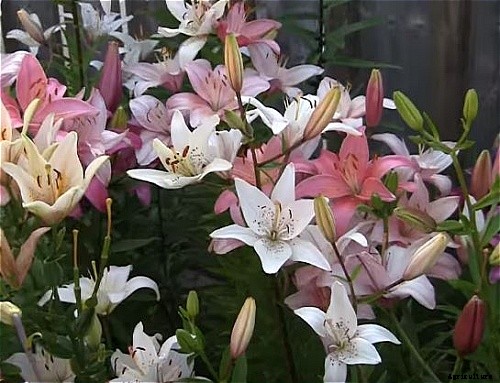
The more familiar species is Zinnia elegans, which includes most Zinnia cultivars, including double-flowered types that grow from one to three feet high. Zinnia linearis grows into a smaller, bushier plant and usually has single flowers. It is also more resistant to powdery mildew than Z. elegans. Hybrids between the two species show this resistance on plants that have traits of both parents.
Zinnias are one of the most popular seeds planted in school gardening projects. The seeds are large enough for little fingers to handle easily, and they germinate and grow quickly, blooming within a couple of months of sowing.
You can get a jump on the season by starting zinnias indoors under lights about 4 to 6 weeks before the average date of your last spring frost. Harden off plants gradually and transplant them into the garden. Afinal, the danger of frost is past when you plant your tomatoes outdoors.
Zinnias like full sun and soil rich in organic matter but loose and friable with good drainage. Their native home is in sandy soil, and they will not grow in heavy clay soils.
The scourge of zinnias is powdery mildew. All varieties can show signs of the disease, with those in the variety Zinnia linearis a little less susceptible. Space the plants the maximum distance recommended for the type you are growing. Don’t water afternoon as this lessens the chance of the foliage being wet after sundown. Se possível, don’t water with an overhead sprinkler.
Remember to deadhead your zinnias by removing faded flowers, and they will continue to bloom until killed by frost. They are often one of the last flowers whose blooms still look good when other annuals have faded.
Zinnias make wonderful cut flowers. They last for a long time, and their wide range of colors makes them compatible with most other flower varieties.
The small varieties looked charming cut with short stems and placed in tiny vases or antique china teacups. Set them in unexpected places throughout the house.
23. Hydrangeas Can Change from Pink to Blue
Hydrangeas are those large, bush-type perennials with giant flower heads in either white, cor de rosa, ou azul. They’re also called “mophead” or “lacecap.”
Fossil records show that hydrangeas grew in North America between 40 and 70 million years ago and about 25 million years ago in Asia.
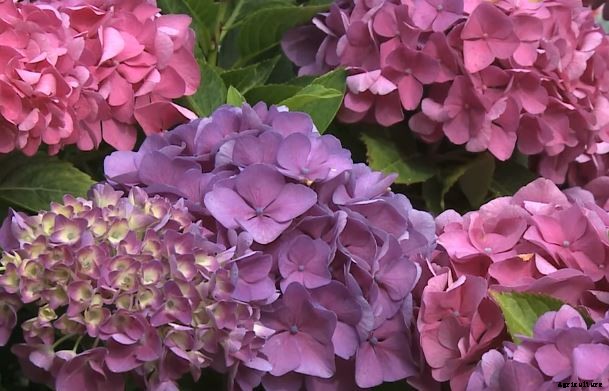
They bloom in mid to late summer and keep their flowers long after their leaves drop off in fall. The flowers looked spectacular on the plants for winter interest in the garden or cut and dried for indoor flower arrangements.
Plant hydrangeas in full sun to partial shade in moist, rico, loamy soil that is well-drained. Add generous amounts of compost when transplanting and top dress with compost every spring.
The name “hydrangea” comes from the Greek words hydro (water) and angeion (vase) or “water vase.” The name doesn’t refer to the flowers; it refers to the shape of the seed capsule.
Hydrangeas are unusual in that you can change the color of their flowers by changing the pH of the soil in which they grow.
To make hydrangeas flowers pink like the ones in the photo above, raise the pH of their soil. Do this by adding dolomitic lime to the soil several times a year (available at garden supply stores). Follow the manufacturer’s instructions for correct quantities and add that amount to the soil around each plant in spring, verão, e cair.
Another thing to do to keep your hydrangeas blooming pink is to use a high phosphorus fertilizer (the second number on the fertilizer label—for example, 10-15-10).
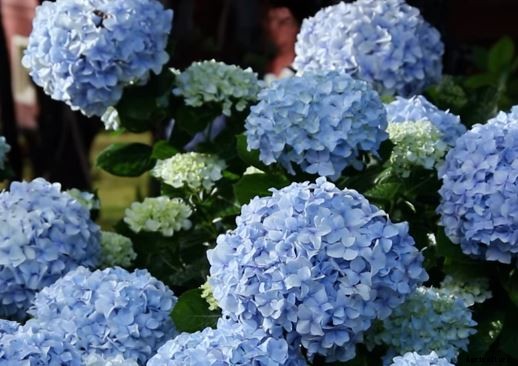
If blue hydrangeas are what you are after, add aluminum sulfate (a soil additive available at garden supply stores) to the soil they are growing. Mix 1 tablespoon aluminum sulfate with one gallon of water and apply a half-gallon of this mixture to the soil around each plant.
Cuidado: water your hydrangeas well the day before you do this so the roots can more easily take up the aluminum sulfate without getting burnt. Apply the aluminum sulfate mixture to the soil in spring, verão, e cair.
To help keep your hydrangeas blooming blue, use a low phosphorus fertilizer (the second number on the fertilizer label) and high in potassium (the third number on the fertilizer label). Por exemplo, use a fertilizer labeled 25-5-30. Avoid using superphosphates or bone meal if trying for blue hydrangeas.
If your best efforts to turn hydrangeas either pink or blue result in them turning the opposite color, the culprit is most likely your water. Water with a high pH will tend to produce pink hydrangeas; conversely, water with a lower pH will produce blue hydrangeas—both despite soil amendments to the contrary.
Finalmente, hydrangeas planted near a concrete foundation or walk will tend to bloom pink because of the considerable amount of lime leaching out of the concrete, which raises the pH of the soil.
One last note on changing the color of hydrangeas:white hydrangeas will always be white and cannot be changed to pink or blue.
Read also:Flowers and Plants for Northern Gardens
24. Lily Varieties Bloom from Summer till Fall
Lilies come in several different varieties with blooming times from midsummer through early fall. Plant some of each variety for a continuous supply of blooms throughout the growing season.

Although you can plant lily bulbs in spring, fall is the best time for planting as it gives them time to develop a strong root system before breaking into vegetative growth the following spring. Potted lilies in active growth can be planted in your garden at any time during the growing season.
Lilies are grown from bulbs with fleshy overlapping scales with no protective covering. Plant them soon after purchasing and don’t allow them to dry out.
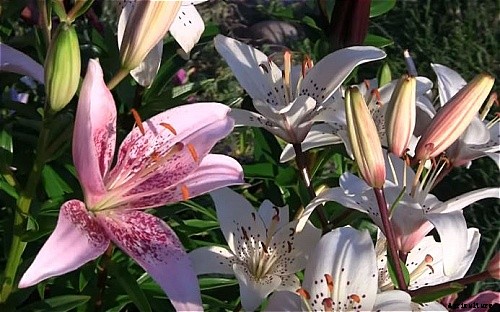
Plant them in well-drained soil in a site where water does not stand after rainfall. Dig down 12 inches and remove rocks. Add peat moss and compost to improve the soil and help with drainage. According to the manufacturer’s recommended quantities, add a little bone meal to the bottom of the hole and scratch it in with your garden claw.
A pleasing way to display lilies in the perennial garden is to plant them in groups of three or five bulbs, spacing the individual bulbs 8 to 12 inches apart. Space the groupings 3 to 5 feet apart. Small bulbs should be planted 2 to 4 inches deep and larger ones 4 to 6 inches deep, as measured from the top of the bulb up to the surface.
Spread organic mulch-like cocoa hulls over the bed. Just before the ground freezes for the winter, add a layer of protective mulch of evergreen boughs, feno, or fallen leaves.
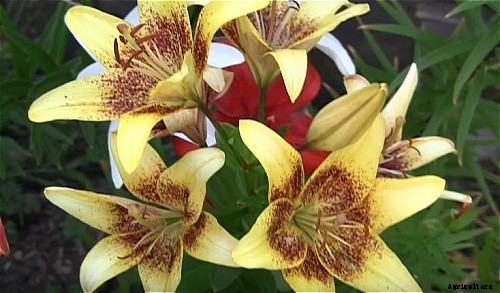
Asiatic lilies start the lily season when they bloom around midsummer. The picture above is of Asiatic lilies blooming right now in Zone 4. Most types of flowers face upward and have few markings on the petals—Hardy in Zones 4 to 9.
Trumpet lilies begin blooming at midsummer. They are named for their trumpet-shaped flowers and are hardy in Zones 5 to 9.
Tiger lilies bloom from midsummer on. They have freckled, pendulous blooms with petals that curve back on themselves. They multiply prolifically and will form large clumps in a few years. Each stem produces many flowers in warm colors, from golden yellow to orange, to red—Hardy in Zones 3 to 9.
Rubrum lilies bloom in late summer to early fall. They resemble Tiger lilies but come in cool colors from white to deep pink. Their blooms are sweetly fragrant—Hardy in Zones 4 to 9.
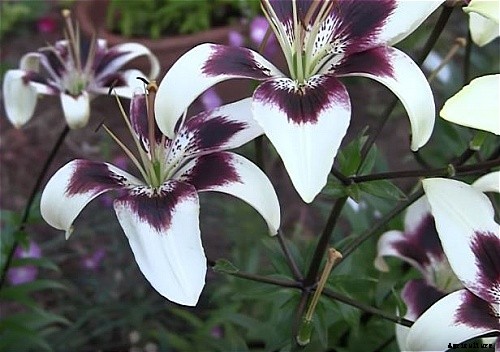
Oriental lilies start blooming in late July, with some varieties not coming into bloom until late August or September. They are intensely fragrant with flowers up to 10 inches across—Hardy in Zones 4 to 9.
Orienpet lilies are a cross between an Oriental and a Trumpet lily. They bloom from mid to late July into mid-August and can reach eight feet high. Flowers come in both warm and cool shades, with some varieties extremely fragrant. They prefer dappled sunlight or morning sun with afternoon shade—Hardy in Zones 4 to 9.
Plant a variety of lilies, so you have a continuous supply of blooms from midsummer through fall.
25. Honeysuckle – Prolific Vines and Fragrant Blooms
Honeysuckle vines, belonging to the Lonicera species, are easy to grow, heat-tolerant, vigoroso, and nearly indestructible. They are commonly used to climb up a trellis, cerca, or another framework. Less well-known is their use as a ground cover for erosion control.
Said to protect your garden from evil, honeysuckle is known as the “love bind” because it symbolizes a lover’s embrace with its clinging growth habit.
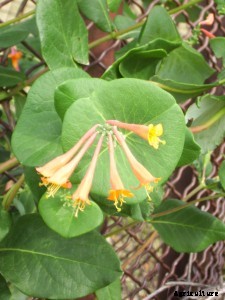
They prefer full sun but will tolerate partial shade. They are drought-resistant once established and only need supplemental fertilizer in early spring and again at midsummer.
Plant honeysuckle in early spring, quando todo o perigo de geada tiver passado. Prepare the planting area by adding peat moss and compost. Dig the soil to a depth of about 6 to 8 inches. Mulch well after planting. Honeysuckle like their leaves in the sun and their roots in the cool shade.
Prune for shape after they finish blooming but only prune lightly until the vines are in their third growing season.
Aphids love honeysuckle, and you’ll need to be vigilant in washing them off with a strong spray from your hose.
Notorious for its sweet scent, honeysuckle vines attract both bees and hummingbirds, who feast on the nectar deep within their elongated blossoms.
Honeysuckle will climb up anything with just a little help from you. Get the vines started climbing by loosely tying them to their supporting structure. They will soon grow and fill it in so much that the supporting structure will virtually disappear.
Folklore tells us that if you bring honeysuckle into your house, there will soon be a wedding. And if you sleep with a sprig of it under your pillow, you will dream sweet dreams.
Of your impending nuptials, no doubt.
26. Lupines Are A Beautiful, Versatile Flower
Spring blooming lupines, Lupinus albus, were cultivated 4, 000 years ago by the Egyptians. In the Americas, Lupinus mutabilis were brought into cultivation 1, 500 years ago.
Although we think of lupines as flowers, they are grown as feed for livestock in many parts of the world. Because they grow well on poor, sandy soils and, na verdade, melhorar o solo, lupines are often grown for soil improvement and followed by a more demanding crop, such as melon, milho, or wheat.
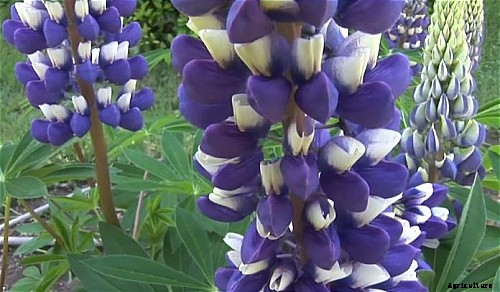
Romans used them medicinally for skin ailments and as an antidote for the bite of an asp, although there is no data on the latter’s effectiveness.
Lupines prefer slightly acidic soil that is well-drained and moderately fertile. They do best in full sun but will grow in partial shade.
Sow annual lupines from seed around the time of your last frost. They will bloom about two months later.
Perennial lupines are best sown from seed in autumn. Soak the seeds in warm water for a day before sowing. They will bloom in mid-spring. You can also start plants indoors about eight weeks before consistent frost-free weather in your area. Plant outside. After all danger of frost is past.
Space lupines about 10 to 12 inches apart. Water regularly and fertilize with a high phosphorous, low nitrogen fertilizer. (Em outras palavras, a low first and a high second number, such as a fertilizer labeled 5-25-10.)
Lupines come in blue, roxa, cor de rosa, amarelo, e branco. They will bloom over and over if you deadhead them by cutting off faded flowers.
Pliny, the Greek writer, and physician claim that the smoke of burnt lupines kills gnats.
I wonder if it works on mosquitoes.
27. Ornamental Salvia Grows Where It Wants To
Salvia is a popular flowering plant for urban gardens. With a combination of over 700 annual and perennial species, there’s a type of salvia out there for everyone.
They can prolifically reseed themselves, like the ones in the photo at left. These are growing in the cut-out area of a sidewalk around the installation of a telephone pole. They most likely blew in from the cultivated salvia growing in a flower bed a couple of houses down the street.
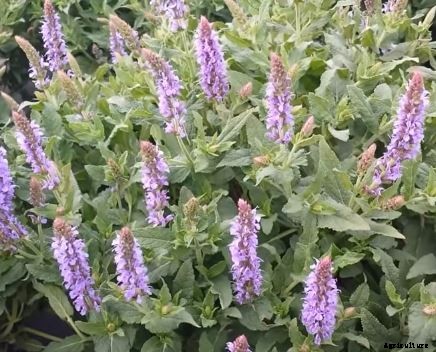
Although I don’t know the variety of this particular salvia, it is most likely one of the tender perennial varieties treated as annuals in temperate regions.
Salvia does best in full sun. Obviamente, they’re not fussy about their soil, only that it should be well-drained.
If you’re planting salvia, you can direct seed it right in the garden in late spring. Sprinkle the seeds on top of the soil. Do not cover; press them in gently with your hand. Mist lightly after you plant them and then mist daily to keep them moist until they germinate.
You can also propagate them by root division, which is best done in spring.
They’re also one of the most popular bedding plants found at garden centers and farmer’s markets every spring.
Space salvia 10 to 20 inches apart, depending on the size at maturity of the variety you’re planting.
Although the red variety of salvia is often planted, the purple variety provides a cool contrast to the hot reds, laranjas, and yellows of most summer-blooming flowers. And it reseeds itself.
28. Pine and Evergreen – Prune in June
In Minneapolis today, workers hoisted the last steel beam to the top of the new baseball stadium.
Attached to the steel beam was a pine tree.
The tradition goes back some 1200 years to the Vikings (somehow appropriate). Scandinavian builders topped off their buildings with a sheaf of grain for the horse of their beloved god, Odin. Para a parte dele, Odin was so pleased with this that he bestowed good luck on the future occupants.
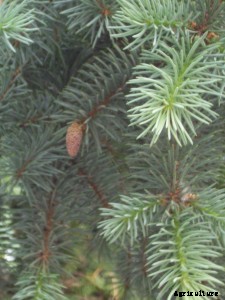
As the Vikings spread throughout (conquered) Europe, they brought their topping off practice with them. Britons and Germans substituted trees for the grain, and interestingly enough, the Scandinavians eventually switched to using a tree.
The tradition was brought to America by Scandinavian ironworkers, who promptly added an American flag. Eventualmente, it became common for the workers to sign the beam before you set it in place.
Not only does raising a pine tree commemorate the building to the highest point of the structure, but it also celebrates doing so without serious injury to the workers.
Pine and evergreen have long symbolized hope to humanity. During the cold, Sombrio, seemingly lifeless winter days, the pine and evergreen remain green and look alive.
Em geral, pine trees do not need pruning. If you do prune a pine, don’t remove whole branches; the tree may never recover. Por exemplo, if a branch is growing into a path, cut a few inches off the tip rather than the entire branch.
Evergreen shrubs and small trees are often pruned to maintain their size and shape in the landscape. June is the ideal time for this.
Novamente, prune sparingly. Only prune off the tips of the branches. If it is necessary to remove an entire branch, do not cut it off flush with the main trunk. Leave a quarter-inch stump.
If you have a large pine or evergreen which has overgrown its space and you’re tempted to cut off the bottom branches, do the tree and yourself a favor and have the tree removed.
Cutting off the lower branches of an evergreen removes the lowest level of support for snow-filled branches. Eventualmente, starting at the bottom, the remaining branches will break under the weight of the snow.
Remove the tree and plant something that loves acid soil, like blueberries or rhododendrons.
Blueberries taste a lot better than pine cones anyway.
29. Zucchini – There’s No Stopping Them
I captured a zucchini blossom this morning on a plant that’s barely bigger than a transplant. It’s actually the second one that opened. I missed the first flower—you can see it wilted in the background in the photo at left.
Abobrinha, come on like gangbusters, and don’t let up until the weather cools in fall. Stories of grocery bags filled with zucchini that were left on neighbor’s doorsteps were circulating in the neighborhood a few years back, but no one came forward as the alleged recipient.
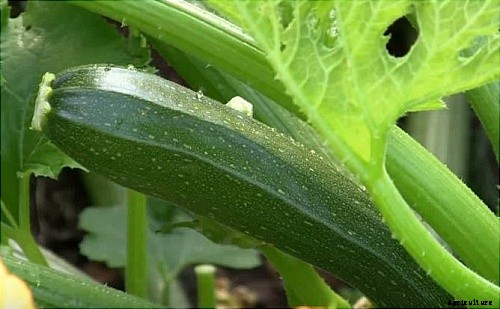
All squash are native to the Americas, but zucchini is a mutant or sport that originated in Italy. Its name comes from the Italian zucchino, which means “little squash.” Botanists called it Cucurbita pepo, a member of the same family as cucumbers and melons. In the United Kingdom and New Zealand, zucchini is referred to as “courgette, ” while Australians and Americans call it “zucchini.”
Whatever you call it, you have to call it versatile. You can serve zucchini cooked or raw, sweet or savory. Zucchini is grilled, frito, deep-fried, recheado, or baked with an endless variety of spices and seasonings. And virtually everything you can do with the fruit of zucchini you can do with the blossom.
Na verdade, one of the ways you can “temper” the amount of zucchini your plants produce is to harvest the blossoms. Stuff them, dip them in tempura batter and deep fry them. Bake them. Put them raw into salads. Use them as a filling for quesadillas.
Sometimes you can find a perfect zucchini blossom still attached to the tiny zucchini fruit at its base. These are much sought after by gourmets and pricey restaurants.
You grow zucchini the same way you grow cucumbers. Plant them in late spring. Afinal, the danger of frost has passed. Plant five or six seeds in “hills” of soil. When the plants are about two inches high, thin to the strongest two or three plants, this is best used for “bush” varieties of zucchini, which form a compact bush-like plant.
For varieties of zucchini that grow into a vine, it’s best to grow them vertically. Zucchini will climb a vertical trellis or net with just a little help from you. Vertical growing keeps the plants off the ground and makes it easier to see the fruits.
Make sure to harvest zucchini every day. Pick fruits before they reach six inches in length when they are the most tender and flavorful. If you miss a few and get a little large, peel them, seed them, grate them, and make zucchini bread. Or add a couple of cups of grated zucchini to any chocolate cake recipe.
Read also:Flower Meaning Perseverance – Magnolia
But try to resist leaving them on your neighbor’s doorstep.
Read also:How To Rebloom Orchids



































